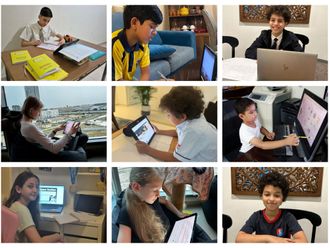
Come September, UAE universities would have to show the same agility and resilience they displayed in responding to the Covid-19 crisis three months ago. With strict precautionary protocols announced for the next academic year including physical distancing rules, their focus is on diversifying the delivery methods to ensure high-quality education with all the concomitant benefits.
“We need to leverage the best of physical place and virtual space to create a community of learners that is not solely bound by either,” says Prof. Esam Agamy, Acting Vice Chancellor for Academic Affairs at University of Sharjah. “The best answer to our situation now is to provide as many courses in blended and hybrid formats as possible.”
Blended learning seems to be the consensus on the way forward, with an eye on offering the best possible university experience.
“We think a blended learning model, a flexible mode of delivery involving the combination of independent, group-based and tutor-facilitated learning, where interactions take place both online and on campus, is very likely to be adopted by many UAE universities in September,” explains Dr Tenia Kyriazi, Deputy Director of Academic Operations at Middlesex University Dubai.
She points out that universities with extensive experience in the use of technology in the classroom are better placed to evolve and transform their provision in an effective and meaningful way. “For more than 20 years, blended learning strategies have been recognised for promoting effective learning, optimising interaction between students and faculty and combining the best features of face-to-face and online education.”
But it hasn’t been put to use on a scale as large as now. However, Covid-19 has set the scene for blended learning to take off in a big way, with the accelerated adoption of edtech across UAE institutions.
“This is a welcome development – many institutions such as BUiD have been able to adapt quickly to using a virtual learning environment as part of their overall learning and teaching offer to students, although it is always important to recognise that technology is simply a facilitator to learning, not the master of it,” says Prof. Abdullah Al Shamsi, Vice Chancellor of the British University in Dubai.
There are umpteen factors to consider while implementing blended learning. What courses work better online; which ones need face-to-face engagement; what are the best digital technologies to use; and how to develop softs skills in students in a time of physical distancing.
“Different platforms serve different learning aims,” explains Dr Kyriazi. “Different tools suit different types of learners and different disciplines require different strategies.”
Prof. Al Shamsi is of the opinion that even if the blended model continues beyond the first term into 2021, students and staff will benefit from a better and more integrated education system where online platforms and technology assist to make the student experience more rounded and diverse.
Then there is the social experience of education to consider. “The social aspect of higher education is an intrinsic component of the student experience and one which we must not overlook in online/blended learning,” says Dr Kyriazi. “Students value the feeling of connection they share with peers and the sense of belonging to the wider academic community. Helping to foster this sense of connection will be particularly important for the incoming 2020-2021 student cohort.
“So it is important to ensure that the face-to-face time spent by students on campus must be optimised, with the use of innovative and effective pedagogic strategies.”
Three months of virtual learning, even though successful, has reiterated what most educators have always known, says Prof. Al Shamsi: nothing can replace the face-to-face, on-campus experience.












